2021 HYUNDAI SANTA FE CALLIGRAPHY inflation pressure
[x] Cancel search: inflation pressurePage 556 of 636
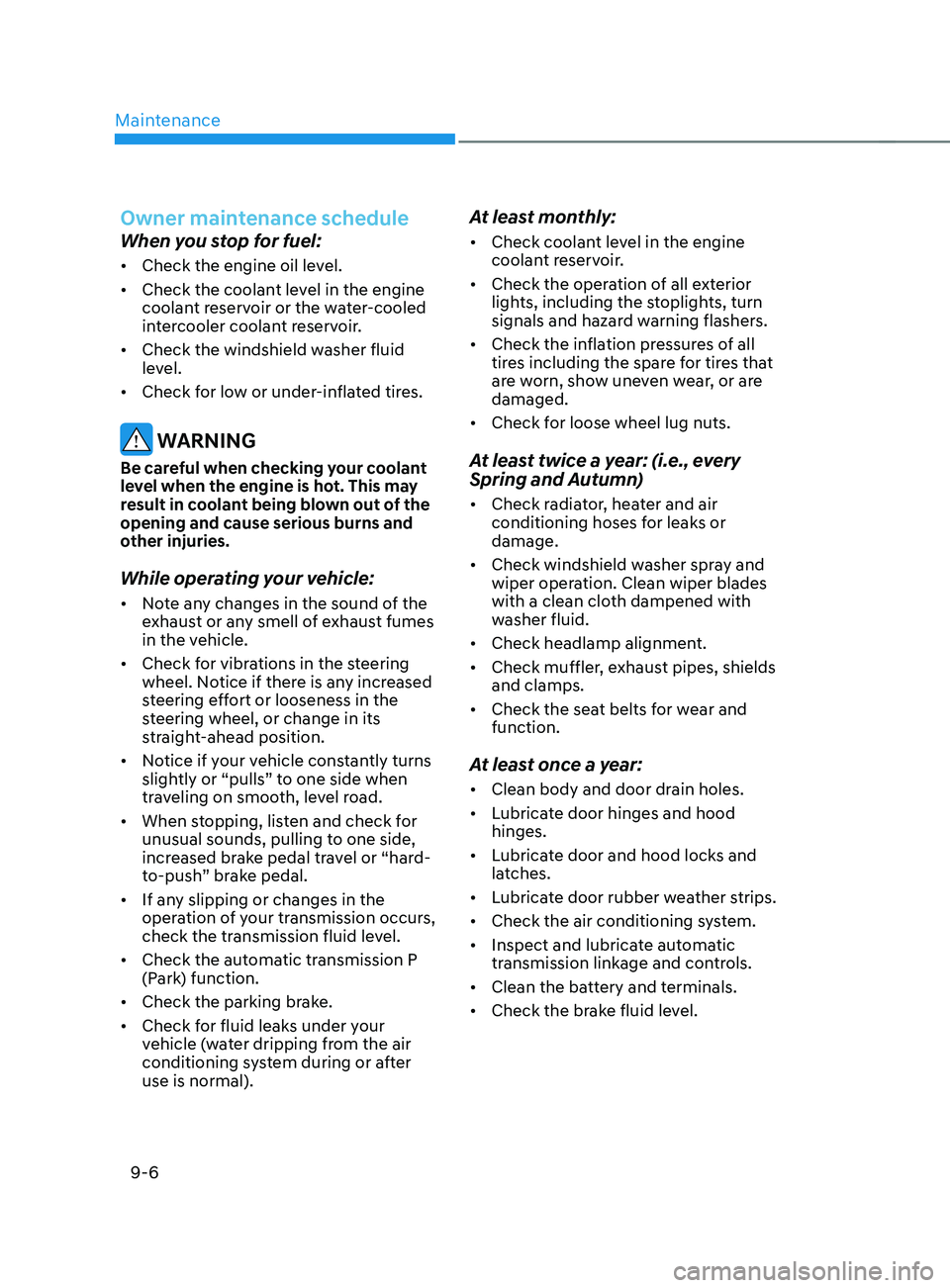
Maintenance
9-6
Owner maintenance schedule
When you stop for fuel:
• Check the engine oil level.
• Check the coolant level in the engine
coolant reservoir or the water-cooled
intercooler coolant reservoir.
• Check the windshield washer fluid
level.
• Check for low or under-inflated tires.
WARNING
Be careful when checking your coolant
level when the engine is hot. This may
result in coolant being blown out of the
opening and cause serious burns and
other injuries.
While operating your vehicle:
• Note any changes in the sound of the
exhaust or any smell of exhaust fumes
in the vehicle.
• Check for vibrations in the steering
wheel. Notice if there is any increased
steering effort or looseness in the
steering wheel, or change in its
straight-ahead position.
• Notice if your vehicle constantly turns
slightly or “pulls” to one side when
traveling on smooth, level road.
• When stopping, listen and check for
unusual sounds, pulling to one side,
increased brake pedal travel or “hard-
to-push” brake pedal.
• If any slipping or changes in the
operation of your transmission occurs,
check the transmission fluid level.
• Check the automatic transmission P
(Park) function.
• Check the parking brake.
• Check for fluid leaks under your
vehicle (water dripping from the air
conditioning system during or after
use is normal).
At least monthly:
• Check coolant level in the engine
coolant reservoir.
• Check the operation of all exterior
lights, including the stoplights, turn
signals and hazard warning flashers.
• Check the inflation pressures of all
tires including the spare for tires that
are worn, show uneven wear, or are
damaged.
• Check for loose wheel lug nuts.
At least twice a year: (i.e., every
Spring and Autumn)
• Check radiator, heater and air
conditioning hoses for leaks or
damage.
• Check windshield washer spray and
wiper operation. Clean wiper blades
with a clean cloth dampened with
washer fluid.
• Check headlamp alignment.
• Check muffler, exhaust pipes, shields
and clamps.
• Check the seat belts for wear and
function.
At least once a year:
• Clean body and door drain holes.
• Lubricate door hinges and hood
hinges.
• Lubricate door and hood locks and
latches.
• Lubricate door rubber weather strips.
• Check the air conditioning system.
• Inspect and lubricate automatic
transmission linkage and controls.
• Clean the battery and terminals.
• Check the brake fluid level.
Page 582 of 636
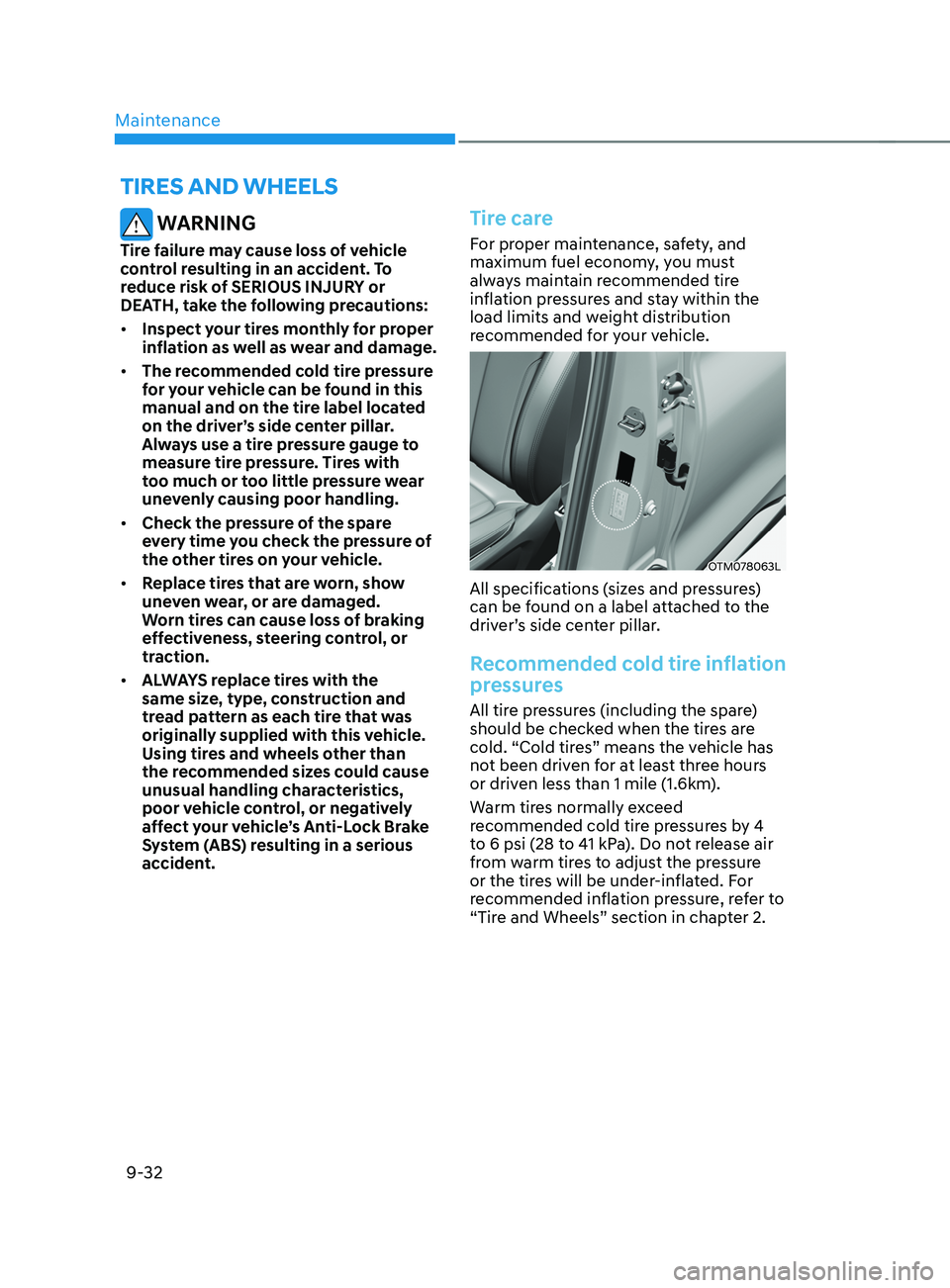
Maintenance
9-32
WARNING
Tire failure may cause loss of vehicle
control resulting in an accident. To
reduce risk of SERIOUS INJURY or
DEATH, take the following precautions:
• Inspect your tires monthly for proper
inflation as well as wear and damage.
• The recommended cold tire pressure
for your vehicle can be found in this
manual and on the tire label located
on the driver’s side center pillar.
Always use a tire pressure gauge to
measure tire pressure. Tires with
too much or too little pressure wear
unevenly causing poor handling.
• Check the pressure of the spare
every time you check the pressure of
the other tires on your vehicle.
• Replace tires that are worn, show
uneven wear, or are damaged.
Worn tires can cause loss of braking
effectiveness, steering control, or
traction.
• ALWAYS replace tires with the
same size, type, construction and
tread pattern as each tire that was
originally supplied with this vehicle.
Using tires and wheels other than
the recommended sizes could cause
unusual handling characteristics,
poor vehicle control, or negatively
affect your vehicle’s Anti-Lock Brake
System (ABS) resulting in a serious
accident.
Tire care
For proper maintenance, safety, and
maximum fuel economy, you must
always maintain recommended tire
inflation pressures and stay within the
load limits and weight distribution
recommended for your vehicle.
OTM078063L
All specifications (sizes and pressures)
can be found on a label attached to the
driver’s side center pillar.
Recommended cold tire inflation
pressures
All tire pressures (including the spare)
should be checked when the tires are
cold. “Cold tires” means the vehicle has
not been driven for at least three hours
or driven less than 1 mile (1.6km).
Warm tires normally exceed
recommended cold tire pressures by 4
to 6 psi (28 to 41 kPa). Do not release air
from warm tires to adjust the pressure
or the tires will be under-inflated. For
recommended inflation pressure, refer to
“Tire and Wheels” section in chapter 2.
TIRES AND WHEELS
Page 583 of 636
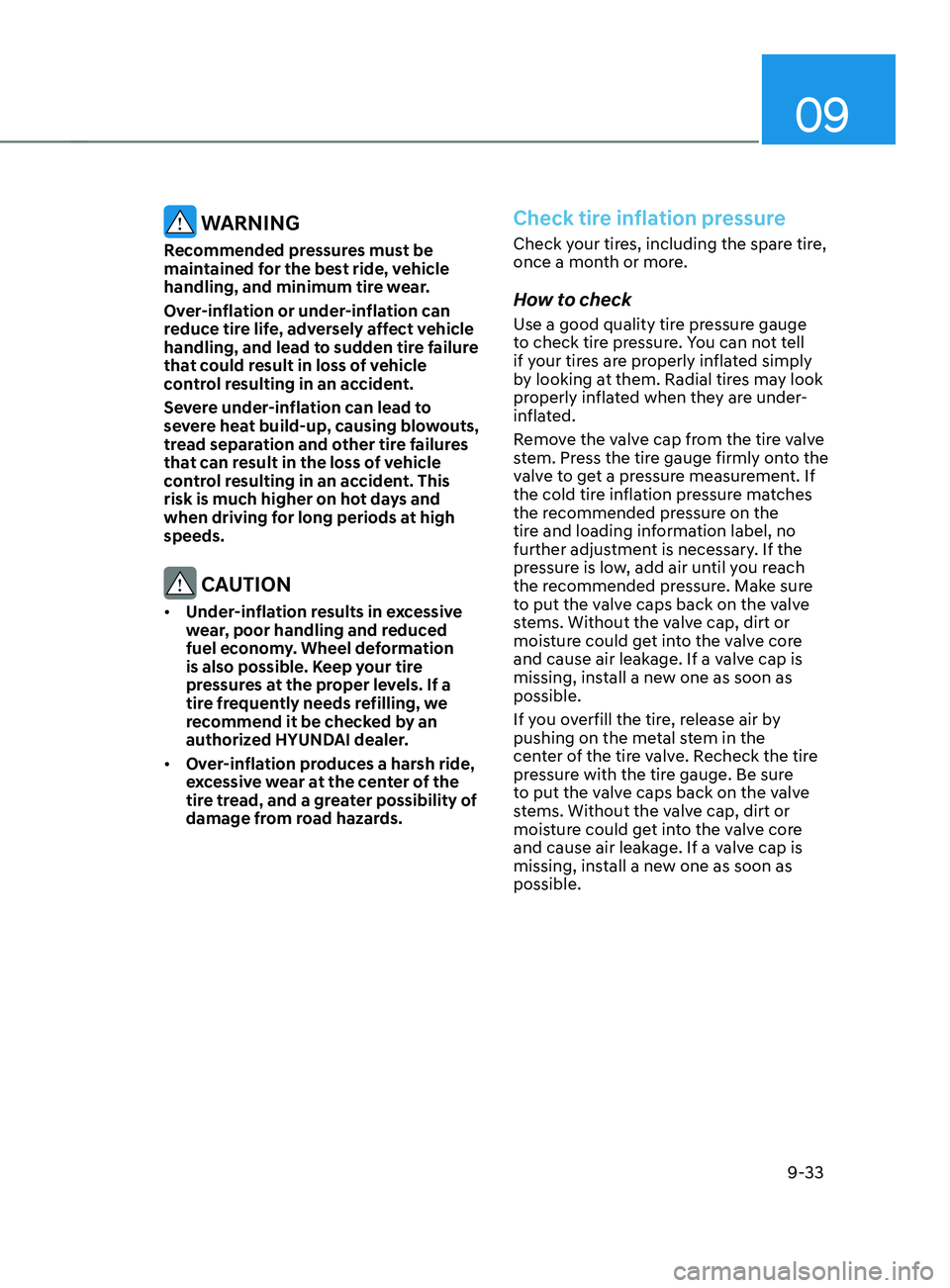
09
9-33
WARNING
Recommended pressures must be
maintained for the best ride, vehicle
handling, and minimum tire wear.
Over-inflation or under-inflation can
reduce tire life, adversely affect vehicle
handling, and lead to sudden tire failure
that could result in loss of vehicle
control resulting in an accident.
Severe under-inflation can lead to
severe heat build-up, causing blowouts,
tread separation and other tire failures
that can result in the loss of vehicle
control resulting in an accident. This
risk is much higher on hot days and
when driving for long periods at high
speeds.
CAUTION
• Under-inflation results in excessive
wear, poor handling and reduced
fuel economy. Wheel deformation
is also possible. Keep your tire
pressures at the proper levels. If a
tire frequently needs refilling, we
recommend it be checked by an
authorized HYUNDAI dealer.
• Over-inflation produces a harsh ride,
excessive wear at the center of the
tire tread, and a greater possibility of
damage from road hazards.
Check tire inflation pressure
Check your tires, including the spare tire,
once a month or more.
How to check
Use a good quality tire pressure gauge
to check tire pressure. You can not tell
if your tires are properly inflated simply
by looking at them. Radial tires may look
properly inflated when they are under-
inflated.
Remove the valve cap from the tire valve
stem. Press the tire gauge firmly onto the
valve to get a pressure measurement. If
the cold tire inflation pressure matches
the recommended pressure on the
tire and loading information label, no
further adjustment is necessary. If the
pressure is low, add air until you reach
the recommended pressure. Make sure
to put the valve caps back on the valve
stems. Without the valve cap, dirt or
moisture could get into the valve core
and cause air leakage. If a valve cap is
missing, install a new one as soon as
possible.
If you overfill the tire, release air by
pushing on the metal stem in the
center of the tire valve. Recheck the tire
pressure with the tire gauge. Be sure
to put the valve caps back on the valve
stems. Without the valve cap, dirt or
moisture could get into the valve core
and cause air leakage. If a valve cap is
missing, install a new one as soon as
possible.
Page 588 of 636
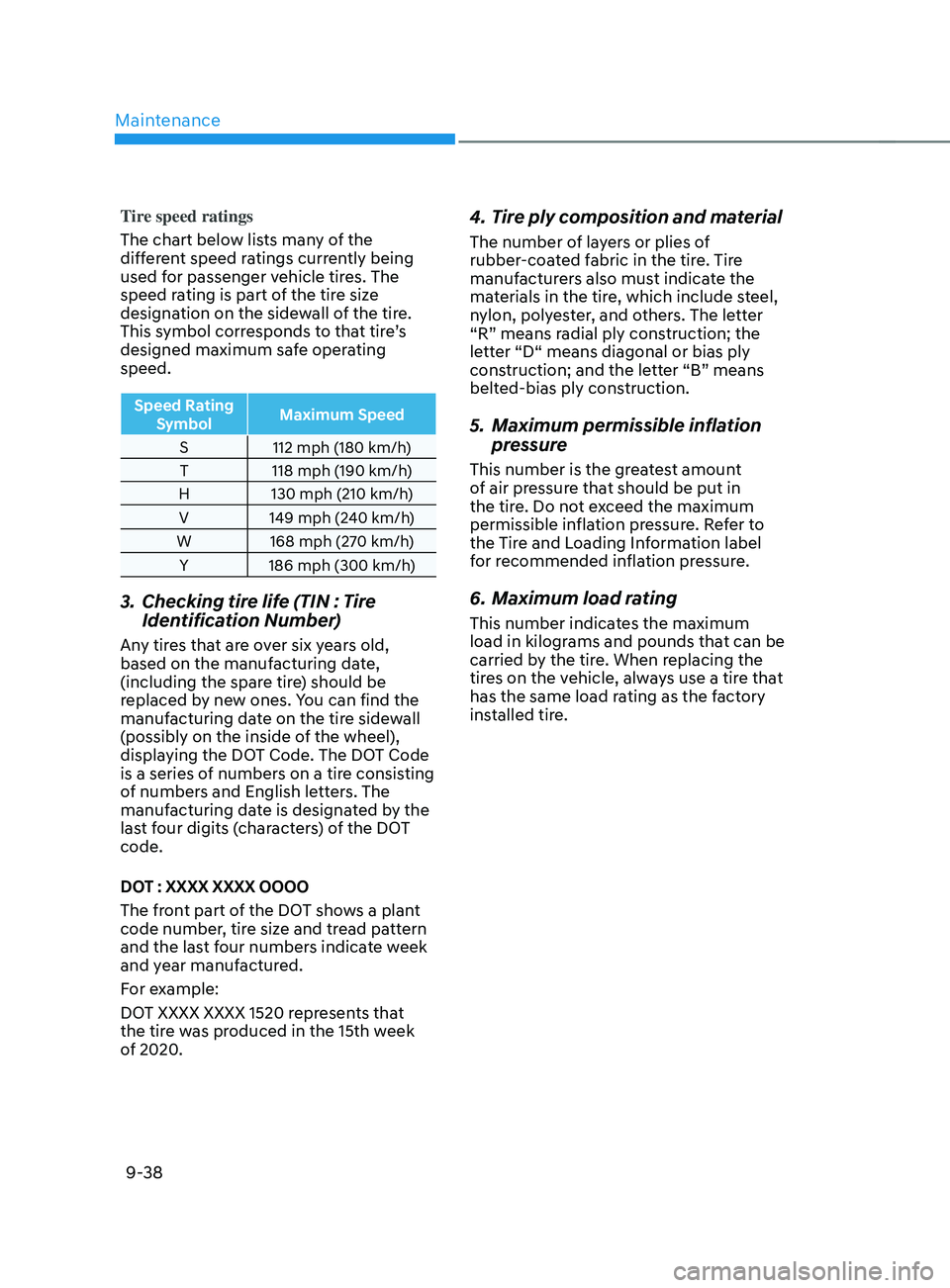
Maintenance
9-38
Tire speed ratings
The chart below lists many of the
different speed ratings currently being
used for passenger vehicle tires. The
speed rating is part of the tire size
designation on the sidewall of the tire.
This symbol corresponds to that tire’s
designed maximum safe operating
speed.
Speed Rating Symbol Maximum Speed
S 112 mph (180 km/h)
T 118 mph (190 km/h)
H 130 mph (210 km/h)
V 149 mph (240 km/h)
W 168 mph (270 km/h) Y 186 mph (300 km/h)
3. Checking tire lif e (TIN : Tire
Identification Number)
Any tires that are over six years old,
based on the manufacturing date,
(including the spare tire) should be
replaced by new ones. You can find the
manufacturing date on the tire sidewall
(possibly on the inside of the wheel),
displaying the DOT Code. The DOT Code
is a series of numbers on a tire consisting
of numbers and English letters. The
manufacturing date is designated by the
last four digits (characters) of the DOT
code.
DOT : XXXX XXXX OOOO
The front part of the DOT shows a plant
code number, tire size and tread pattern
and the last four numbers indicate week
and year manufactured.
For example:
DOT XXXX XXXX 1520 represents that
the tire was produced in the 15th week
of 2020.
4. Tire ply composition and material
The number of layers or plies of
rubber-coated fabric in the tire. Tire
manufacturers also must indicate the
materials in the tire, which include steel,
nylon, polyester, and others. The letter
“R” means radial ply construction; the
letter “D“ means diagonal or bias ply
construction; and the letter “B” means
belted-bias ply construction.
5. Maximum permissible inflation
pr essure
This number is the greatest amount
of air pressure that should be put in
the tire. Do not exceed the maximum
permissible inflation pressure. Refer to
the Tire and Loading Information label
for recommended inflation pressure.
6. Maximum load rating
This number indicates the maximum
load in kilograms and pounds that can be
carried by the tire. When replacing the
tires on the vehicle, always use a tire that
has the same load rating as the factory
installed tire.
Page 590 of 636
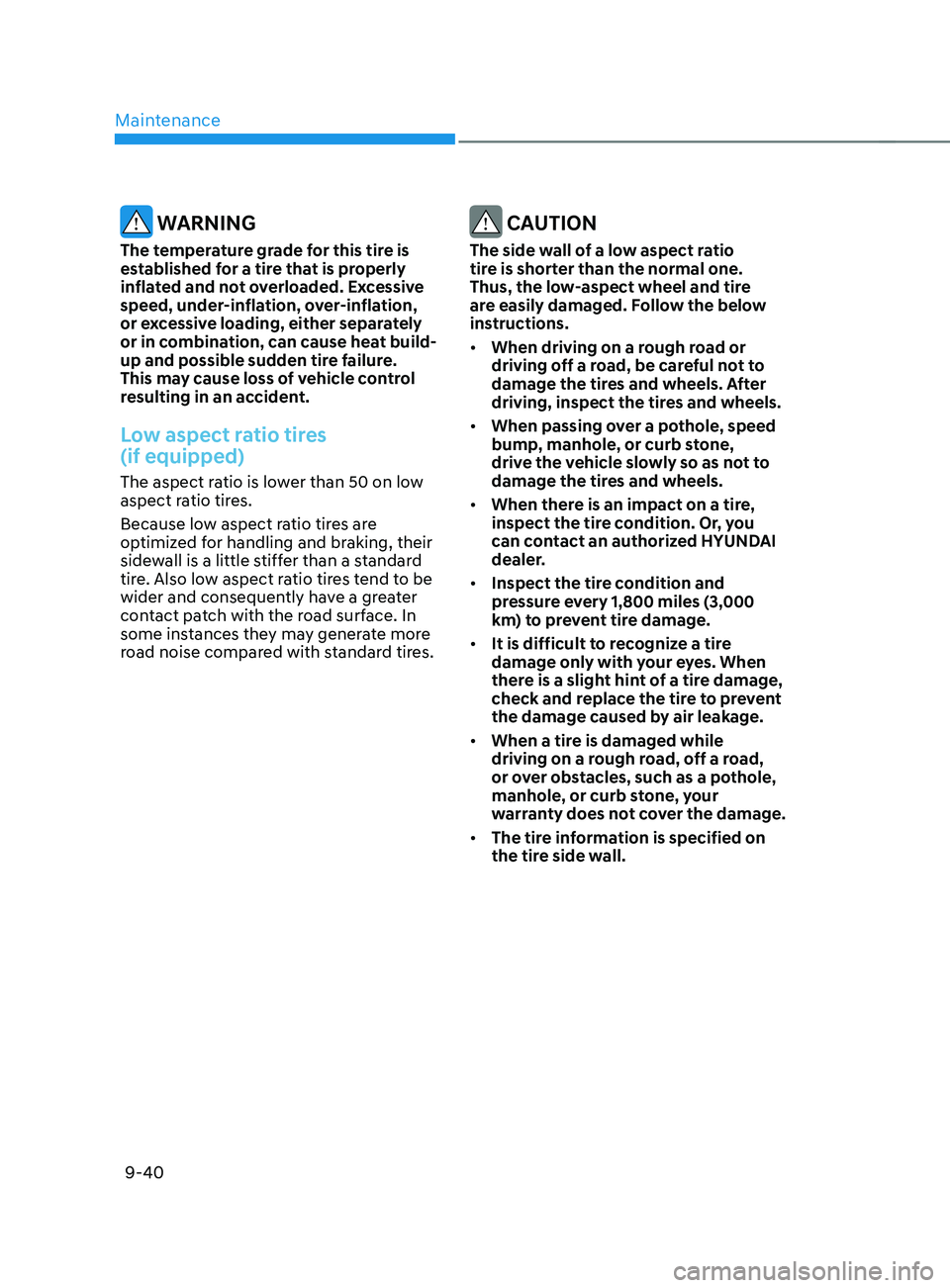
Maintenance
9-40
WARNING
The temperature grade for this tire is
established for a tire that is properly
inflated and not overloaded. Excessive
speed, under-inflation, over-inflation,
or excessive loading, either separately
or in combination, can cause heat build-
up and possible sudden tire failure.
This may cause loss of vehicle control
resulting in an accident.
Low aspect ratio tires
(if equipped)
The aspect ratio is lower than 50 on low
aspect ratio tires.
Because low aspect ratio tires are
optimized for handling and braking, their
sidewall is a little stiffer than a standard
tire. Also low aspect ratio tires tend to be
wider and consequently have a greater
contact patch with the road surface. In
some instances they may generate more
road noise compared with standard tires.
CAUTION
The side wall of a low aspect ratio
tire is shorter than the normal one.
Thus, the low-aspect wheel and tire
are easily damaged. Follow the below
instructions.
• When driving on a rough road or
driving off a road, be careful not to
damage the tires and wheels. After
driving, inspect the tires and wheels.
• When passing over a pothole, speed
bump, manhole, or curb stone,
drive the vehicle slowly so as not to
damage the tires and wheels.
• When there is an impact on a tire,
inspect the tire condition. Or, you
can contact an authorized HYUNDAI
dealer.
• Inspect the tire condition and
pressure every 1,800 miles (3,000
km) to prevent tire damage.
• It is difficult to recognize a tire
damage only with your eyes. When
there is a slight hint of a tire damage,
check and replace the tire to prevent
the damage caused by air leakage.
• When a tire is damaged while
driving on a rough road, off a road,
or over obstacles, such as a pothole,
manhole, or curb stone, your
warranty does not cover the damage.
• The tire information is specified on
the tire side wall.
Page 629 of 636

I
I -7
I
Idle Stop and Go (ISG)
........................................................................\
...............6-61
Forced to restart engine ........................................................................\
............6-64
ISG malfunction ........................................................................\
....................... 6-65
ISG system off ........................................................................\
.......................... 6-64
ISG system operation ........................................................................\
...............6-61
If the engine overheats
........................................................................\
................... 8-7
If the engine will not start
........................................................................\
.............. 8-3
If you have a flat tire (with spare tire)
................................................................. 8-14
Changing tires ........................................................................\
.......................... 8-16
Jack and tools ........................................................................\
........................... 8-14
Jack label ........................................................................\
.................................. 8-21
Removing and storing the spare tire .................................................................8-14
If you have a flat tire (with
Tire Mobility Kit)
.................................................... 8-22
Checking the tire inflation pressure ................................................................. 8-28
Components of the T
ire Mobility Kit
............................................................... 8-24
Introduction ........................................................................\
.............................. 8-22
Notes on the safe use of the T
ire Mobility Kit
.................................................8-23
Using the T
ire Mobility Kit
........................................................................\
...... 8-25
Ignition switch
........................................................................\
............................... 6-5
Key ignition switch ........................................................................\
....................6-5
Key ignition switch positions ........................................................................\
.....6-6
Starting the engine ........................................................................\
...................... 6-7
Important safety precautions
........................................................................\
.......... 3-2
Air bag hazards ........................................................................\
........................... 3-2
Always wear your seat belt ........................................................................\
........3-2
Control your speed ........................................................................\
..................... 3-2
Driver distraction ........................................................................\
........................ 3-2
Keep your vehicle in safe condition ...................................................................3-2
Restrain all children ........................................................................\
................... 3-2
In case of an emer
gency while driving
.................................................................. 8-2
If the engine stalls at a crossroad or crossing .....................................................8-2
If the engine stalls while driving ........................................................................\
8-2
If you have a flat tire while driving ....................................................................8-3
Page 635 of 636
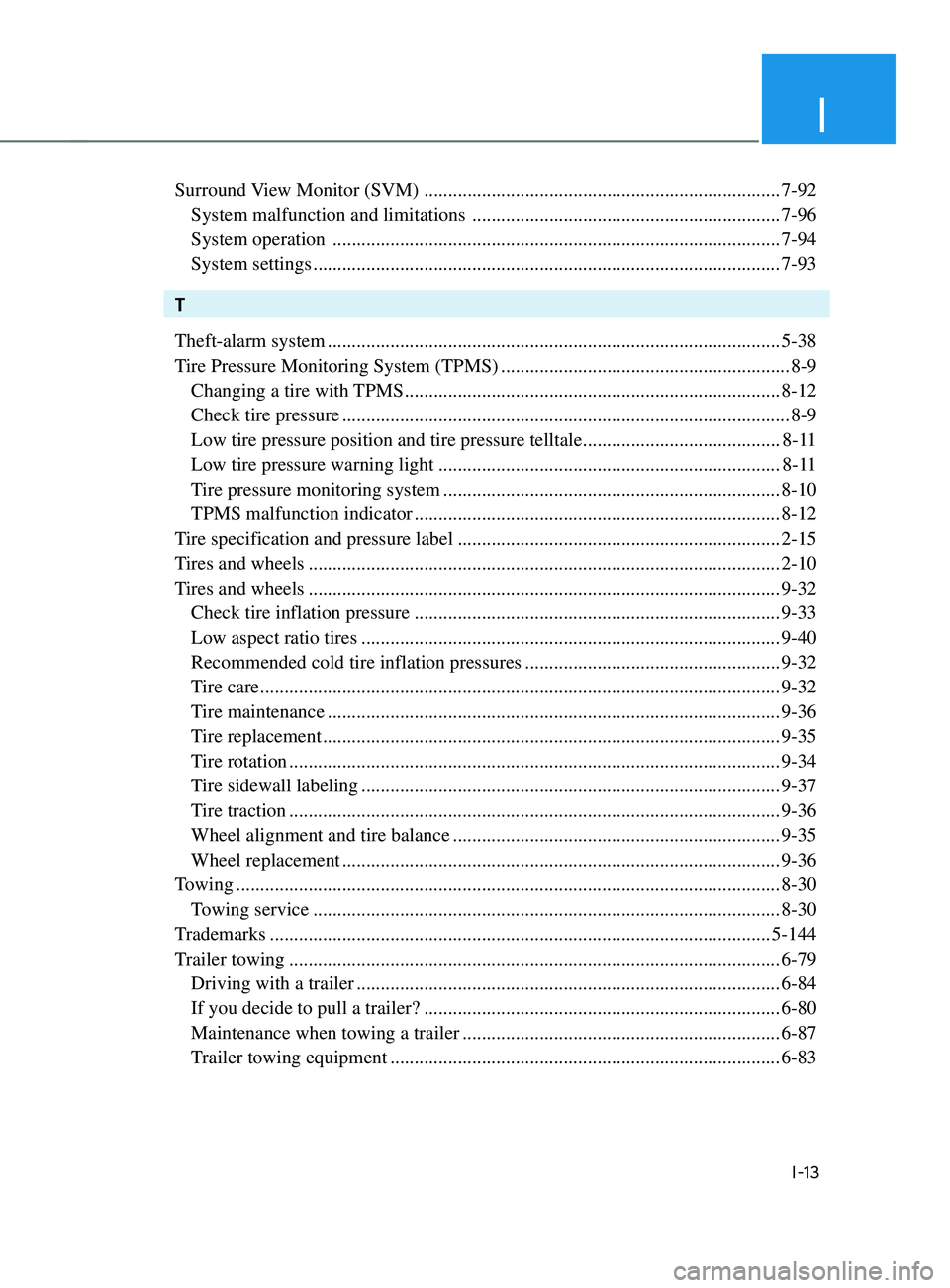
I
I-13
Surround View Monitor (SVM) ........................................................................\
..7-92
System malfunction and limitations ................................................................7-96
System operation ........................................................................\
..................... 7-94
System settings ........................................................................\
......................... 7-93
T
Theft-alarm system
........................................................................\
...................... 5-38
T
ire Pressure Monitoring System (TPMS)
............................................................ 8-9
Changing a tire with TPMS ........................................................................\
...... 8-12
Check tire pressure ........................................................................\
..................... 8-9
Low tire pressure position and tire pressure telltale .........................................8-1
1
Low tire pressure warning light .......................................................................8-1
1
Tire pressure monitoring system ......................................................................8-10
TPMS malfunction indicator ........................................................................\
.... 8-12
T
ire specification and pressure label
................................................................... 2-15
T
ires and wheels
........................................................................\
.......................... 2-10
T
ires and wheels
........................................................................\
.......................... 9-32
Check tire inflation pressure ........................................................................\
....9-33
Low aspect ratio tires ........................................................................\
............... 9-40
Recommended cold tire inflation pressures .....................................................9-32
Tire care ........................................................................\
.................................... 9-32
Tire maintenance ........................................................................\
......................9-36
Tire replacement ........................................................................\
....................... 9-35
Tire rotation ........................................................................\
.............................. 9-34
Tire sidewall labeling ........................................................................\
...............9-37
Tire traction ........................................................................\
.............................. 9-36
Wheel alignment and tire balance ....................................................................9-35
Wheel replacement ........................................................................\
................... 9-36
T
owing
........................................................................\
......................................... 8-30
Towing service ........................................................................\
.........................8-30
T
rademarks
........................................................................\
................................ 5-144
T
railer towing
........................................................................\
.............................. 6-79
Driving with a trailer ........................................................................\
................6-84
If you decide to pull a trailer? ........................................................................\
..6-80
Maintenance when towing a trailer ..................................................................6-87
Trailer towing equipment ........................................................................\
......... 6-83